Teaching requires the ability to clearly convey complex ideas. I try to balance theory with real world examples and interactive learning. I believe that applying fundamental concepts through hands-on experience can help to clarify aspects that may seem very complicated, at first glance. Because most classes are taught in a vertical learning style, in which new concepts build on previous ones, I believe that continual emphasizing and reinforcing of basic theories are critical to continued understanding of the course material. This is a lesson I learned from the most effective classes I have taken, and a technique I employ in my classes.
I am working on two new methods for enhancing engineering education:
I am working on two new methods for enhancing engineering education:

Guided Notes - In all of my current classes I use guided notes to assist students with note-taking, make my lectures more efficient. I generate complete powerpoint lectures for myself, and then I remove several key parts and provide the 'incomplete' versions of the lectures for the students online. I then use a tablet PC to lecture and fill in the notes during class.
Advantages I have found:
Advantages I have found:
- The students learn by taking notes, and by having key images provided. My artistry is terrible, so making use of excellent images helps convey difficult concepts.
- Me filling in the lectures helps pace my lectures so that I do not go too fast for the students.
- My notes are visually organized for the students (e.g., common color-coded header for each concept
Scaffold & Fade Problem Sets - For the last 5 years I have been developing several sets of problems in Fluid Mechanics that use 'scaffold and fade' techniques. Our 'modules' consist of a single video that includes a narrative and problem solving exercise. We follow that with 3 problems delivered to students through our course management system. The first of these 3 problems is similar to the example one in the video, and the second and third problems are progressively more difficult. For all problems, we ask several questions related to solving the problem (e.g., at what points would it be most advantageous to apply Bernoulli's equation, etc.). For problems 1 and 2, we provide the students with links to parts of the video that are pertinent to the question at hand. This is the scaffolding or support for the student's learning. The third problem has no links provided (i.e., we have 'faded' the support). By the third problem, students will hopefully have learned enough to solve the problem on their own.
Classes Taught at University of Colorado:
Classes Taught at Colorado State University:
Classes Taught at Penn State:
- CVEN 5333 - Physical Hydrology (Fall 2015, Fall 2016, Fall 2017)
- CVEN 4833/5833 - Open Channel Hydraulics (Spring 2017)
- CVEN 5833 - Surface Water Quality Modeling (Spring 2017)
- CVEN 5833 - Initiating Your Academic Career (Fall 2016)
Classes Taught at Colorado State University:
- CIVE 102 - Introduction to Civil Engineering (Fall 2013, Fall 2014).
- CIVE 542 - Water Quality Modeling (Fall 2013)
- CIVE 531 - Groundwater (Fall 2014)
- CIVE 592 - Surface Water - Groundwater Interactions (Spring 2015)
- ECOL 592 - Sustaining Riverscapes (Fall 2014)
Classes Taught at Penn State:
- CE 360 - Fluid Mechanics (Spring, 2008, Spring 2009, Fall 2009, Fall 2011)
- CE 462 - Open Channel Hydraulics (Spring 2009, Spring 2010, Spring 2011)
- CE 497 - Ecological Engineering (Fall 2009)
- CE 597 - Surface Water Quality Modeling (Fall, 2008, Spring 2011)
- CE 597 - Initiating your Academic Career (Fall, 2008, Fall 2009, Fall 2010, Fall 2011)
- CE 597A – Ecology, Ecohydraulics, and Environmental Hydrology of Streams: Field Methods & Theory (Spring 2008)
- GEGN 598 – Surface Water Hydrology (Fall 2005, Fall 2006)
- GEGN 598 – Snow Hydrology (Spring 2006)
- GEGN 398 – Environmental Fluid Mechanics (Spring 2007)
- GEGN 467 – Senior Design (Spring 2007)
- AWER 4490/5490 – Small Watershed Hydrology (Spring 2003, Fall 2003)
- AWER 6940 – Snow Hydrology (Spring 2004)